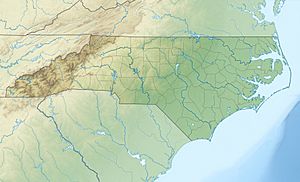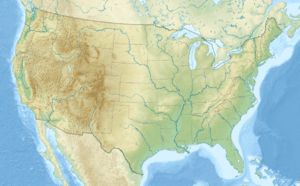Betty McGees Creek (Uwharrie River tributary) facts for kids
Quick facts for kids Betty McGees Creek |
|
|---|---|
|
Location of Betty McGees Creek mouth
|
|
| Other name(s) | Tributary to Uwharrie River |
| Country | United States |
| State | North Carolina |
| County | Randolph |
| Physical characteristics | |
| Main source | Hannahs Creek divide about 6 miles northwest of Pisgah in the Birkhead Mountains Wilderness 810 ft (250 m) 35°36′24″N 079°54′10″W / 35.60667°N 79.90278°W |
| River mouth | Uwharrie River about 5 miles northeast of New Hope, North Carolina 375 ft (114 m) 35°36′30″N 079°58′06″W / 35.60833°N 79.96833°W |
| Length | 9.09 mi (14.63 km) |
| Basin features | |
| Progression | north then southwest |
| River system | Pee Dee |
| Basin size | 8.29 square miles (21.5 km2) |
| Tributaries |
|
| Bridges | Tot Hill Farm Road, Stone Bridge Road, Tot Hill Farm Road, Lassister Mill Road |
Betty McGees Creek is a small stream, about 9.09 miles (14.63 km) long. It's like a smaller river that flows into a bigger one, the Uwharrie River. You can find it in Randolph County, North Carolina. It's called a "2nd order" stream, which means it's formed when two smaller streams (1st order) join together.
Other Names
Sometimes, Betty McGees Creek has been called by slightly different names. These include:
- Bellie McGees Creek
- Bettie McGees Creek
Where It Starts and Flows
Betty McGees Creek begins in a wild area called the Birkhead Mountains Wilderness. This is in Randolph County, North Carolina, about 6 miles (9.6 km) northwest of a place called Pisgah.
The creek first flows north. Then, it makes a curve and heads southwest. Finally, it joins the Uwharrie River. This meeting point is about 5 miles (8 km) northeast of New Hope, North Carolina.
The Creek's Watershed
A watershed is an area of land where all the water drains into a single stream, river, or lake. The Betty McGees Creek watershed covers about 8.29 square miles (21.5 square km).
This area gets a good amount of rain, about 46.9 inches (119 cm) each year. A large part of the watershed, about 79%, is covered by forests. This helps keep the water clean and healthy for animals and plants.



